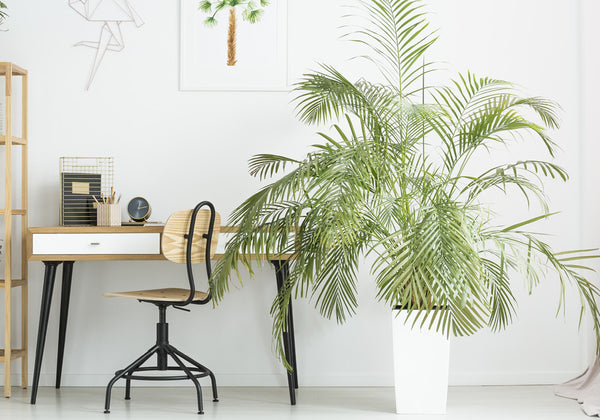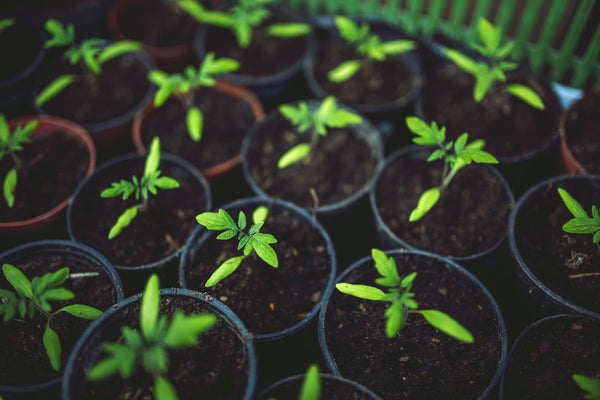Image: Festoon House Lighting.
Embraced by deeply-hued foliage, sleek silhouettes, fresh fruit and beyond, each houseplant is a study in lively decor...literally. And with our comprehensive buying guide, you’ll be well on your way to maximized looks in every nook and cranny of your home, office and beyond.
What are the Most Popular Houseplants?
There’s a lot to love when it comes to houseplants, from their versatility to their good looks and low-maintenance care. Plus, with our handy guide, you’ll have all you need to pick your favorites, plant, maintain and help each variety thrive (no green thumb required).

Easy Care Houseplants
Simply position houseplants carefully, find the ideal spot and voilà – you’re ready to go. And don’t be afraid of a bit of trial and error since it can take moving your plants around a few times to find the best fit. For example, houseplants that grow best in sunny locales should be positioned near South-facing windows (for those of us in the Northern hemisphere, at least!).
From there, proper watering, pruning and the occasional fertilizer application take houseplants to the next level of health. Good health = amazing looks, fruit production, savory spice and more. And if you're still daunted, try a few of our easy care houseplants to get you started.
Unique Houseplants
When it comes to house-plant beauty, you really can’t go wrong. Each variety has something special to offer: the eye-catching chasms of the Swiss Cheese Plant, the famously full cast of the Fiddle-Leaf Fig, the sweet, succulent flavors of the Meyer Lemon. No matter your decor style, houseplants are like the perfect underscore to each space, traditional or modern.
How to Decorate with Houseplants
Sleek sophistication in a polished package, built for areas both large and small. Is there anything better than a nearly-personalized plant? Whether you’re looking for larger-than-life vibes or a diminutive complement, houseplants fit the bill.
Furthermore, we love the houseplants that pull double duty as a focal point and utilitarian go-to. From the Bay Laurel to the Rosemary Tree, edible plants and fruit trees are like a lush, eco-friendly spice rack or kitchen-friendly orchard.
How to Care for Houseplants
But as easy as it is to buy and care for houseplants, a bit of planning is a must. Whether you’re positioning your plants for greatness or choosing a watering schedule, it’s essential to ensure you’ve ticked every box of preparation. And though a plethora of houseplants almost thrive on neglect, they grow best in the right conditions with adequate care.

How to Plant Houseplants
You’ve scouted the area, you’ve cleared the space for your new favorite picks, and you’re ready to go. Luckily, planting and transferring houseplants after they’ve shipped is one of the most effortless steps.
To start, take your houseplant out of its shipped nursery container and plant it in a pot that is at least a third larger than the root ball on all sides. This is important to ensure it has plenty of room to spread out and get established.
Also, ensure your chosen pot has drainage holes to avoid root rot. And dispose of any standing water in your pot’s saucer to avoid fungal growth.
Unpacking and Watering Houseplants
- Moisten the soil in the shipped container. As you remove the plant from its container, loosen its roots gently with your fingers to separate clumps.
- Line the bottom of your new pot with a layer of clean soil, approximately three inches deep. After you’ve placed the plant in its home container, fill the sides with fresh soil and sprinkle a bit of soil on the top of the root ball as well.
- Water your newly re-potted plant.
And that’s all there is to it. Transitioning your houseplants to their more permanent homes is as easy as 1-2-3.
How to Care for Houseplants
So, transferring and planting your houseplants is really that simple. Seriously – there’s not a lot of effort involved when it comes to most of these prime picks. But proper care after planting is vital for giving your selections a head start on a lush life.
Watering Your Houseplants
First of all, it’s vital that your houseplant’s container has drainage holes. Without drainage holes, roots can get waterlogged, leading to root rot or other plant ailments.
When you’re ready to water, ensure that the plant’s soil feels dry to the touch, and only water if it does. We use the finger check to determine soil moistness: if you have dirt on your finger after sticking it in the soil (tacky, sticky soil is best because it’s hydrated), your plant should be good. If the soil is dry and doesn’t stick to your finger, it’s time to water. Keep in mind that you should water your houseplants more frequently during dry weather, hot or cold.
And most indoor plants love an occasional misting of water. Use a spray bottle with room temperature water to mist your houseplants, especially those that prefer humidity. This can also help combat any damage from central heat and air, which tend to dry out houseplants.
*Tip: Watered from the bottom, now the growth is here. Watering plants from the bottom of the pot or concentrating water delivery at the soil helps preserve foliage and keep disease away.
How to Fertilize Houseplants
Thankfully, you don’t need a lot of fertilizer for your houseplants to grow big and strong. Feed your plants with small amounts of fertilizer – the fastest method is complete liquid fertilizer in the recommended dose for your specific plant varieties, usually applied every two to four weeks. Follow label instructions for best results.
How to Prune Houseplants
Pruning is not always necessary, but it does help to maintain a neater, cleaner appearance. Start with a clean pair of sharp scissors or gardening shears (dull blades can damage plants). Using clean tools is essential so that your plants are not exposed to bacteria, pests or other diseases during pruning.
The ideal time to prune will depend on the houseplant, however. Usually, we advise that you prune your plants at the beginning of their growing season. If you have houseplants that don’t flower, you should prune them during late winter. For those with blooms, wait until the flowers emerge before you prune. Avoid pruning your houseplants when you see unopened buds on the stems.
When you’re ready to roll up your sleeves and begin, you should start by removing any dead leaves, limbs, and flowers. After that, you should cut back overgrown branches and stems on the plants until you’ve achieve your desired look.
Common Causes of Pests and Diseases
Improper lighting, placement near air vents, dried-out soil, waterlogged roots. There are a myriad of causes for less-than-stellar plant performance.
Though leaves may wilt and blooms may drop temporarily, most houseplants are fairly hearty. The biggest battle when it comes to maintaining houseplants is finding a happy medium for ideal results.
For example, soil can’t be too wet or too dry. Houseplants need a sunny atmosphere but too much direct sunlight can burn the plant.
Luckily, a little trial and error is all it takes to reach the that sweet spot of maximized growth and minimized fuss for your houseplants. And your houseplants are the best indicators for their own care – they’ll tell you what they need because inadequate care shows, from the foliage to the soil.
Pests and Diseases
Although most pests and diseases can be avoided rather easily, it’s important to keep a watchful eye for the most common nuisances:
- Aphids
- Caterpillars
- Cyclamen mites
- Earwigs
- Eelworms
- Mealybugs
- Red spider mites
- Root mealybugs
- Scale insects
- Thrips
- Whiteflies
And a few prevalent diseases to be aware of are:
- Black leg
- Botrytis
- Leaf spot
- Powdery mildew
- Root rot
- Rust
- Sooty mold
Getting Rid of Pests and Diseases on Houseplants
Thankfully, treating plants and mitigating these issues is simple. Most pests are eliminated when they’re sprayed with a concentrated insecticide, typically diluted in clean water. You can also water your soil or compost with a systemic insecticide that treats the houseplant’s root system.
Dusting plants is another effective and cheap way to rid your plant of diseases and pests. Just make sure to distribute the treatment powder evenly, and perform all pest and disease treatment outdoors for safety purposes.
But like we said, an ounce of prevention is worth a pound of cure. Ideal conditions, including attention and proper care, from the start help houseplants perform well.

Popular Types of Houseplants
Now that you know all about the care and maintenance of houseplants, how about some of our favorite botanicals? Whether it’s healthful houseplants with spice, exotic plants that elevate any space, and pet-friendly houseplants safe for cats and dogs, we have an array of offerings well-suited to most spaces.
Fiddle-Leaf Fig
We can’t talk about houseplants without talking about this super sleek staple. With sizable, eye-catching foliage and a silhouette that truly stands out, the Fiddle-Leaf Fig Tree is an indoor star.
Even better? It’s easy to maintain once you get the hang of it. With our pointers and tailored care tips for the Fiddle-Leaf, you’ll be well on your way to an elevated look in any space. In fact, it works for you since it's one of our houseplants that clean the air!
Swiss Cheese Plant
Heart-shaped, glossy leaves lend a full look to Monstera, also known as the one-of-a-kind Swiss Cheese Plant. Its namesake is derived from its full leaves that develop diminutive, natural holes – resembling the holes in Swiss cheese – for a unique appearance, tailored for year-round display.
And though the trademark punctuations on the leaves develop after one to two years of growth, this plant’s lush, vividly-green hues impress from day one. Plus, it's one of our low light houseplant varieties, so it couldn't be easier to grow.
Croton Petra
Croton Petras are compact container plants that thrive anywhere indoors, kitchen, office and beyond.
We love the Croton because it’s synonymous with vivid vibes of summer, imparting an exotic look to indoor decor from season to season. The bright hues on the large, waxy and oval-shaped leaves belie a tropical look to brighten even the darkest spaces.
Arabica Coffee Plant
Last but not least, we adore houseplants that moonlight as bold beauties and mini orchards or spice producers. The Arabica Coffee Plant is no exception.
Imagine harvesting fresh, aromatic coffee beans right from your backyard or tabletop. During the ripening process, this houseplant’s coffee beans transition from green to yellow, then a rich orange hue, and finally to deep, dramatic red for visual interest that lives up to its delectable growth.
And not only does the Arabica Coffee produce fragrant beans, but it also brings jasmine-scented blooms during spring.
These horticultural must-haves embody everything we love about going green: from no-nonsense, hassle-free care to elegant looks plus fruit and spice, our favorites take indoor locales, patios, porches and beyond to new heights.





